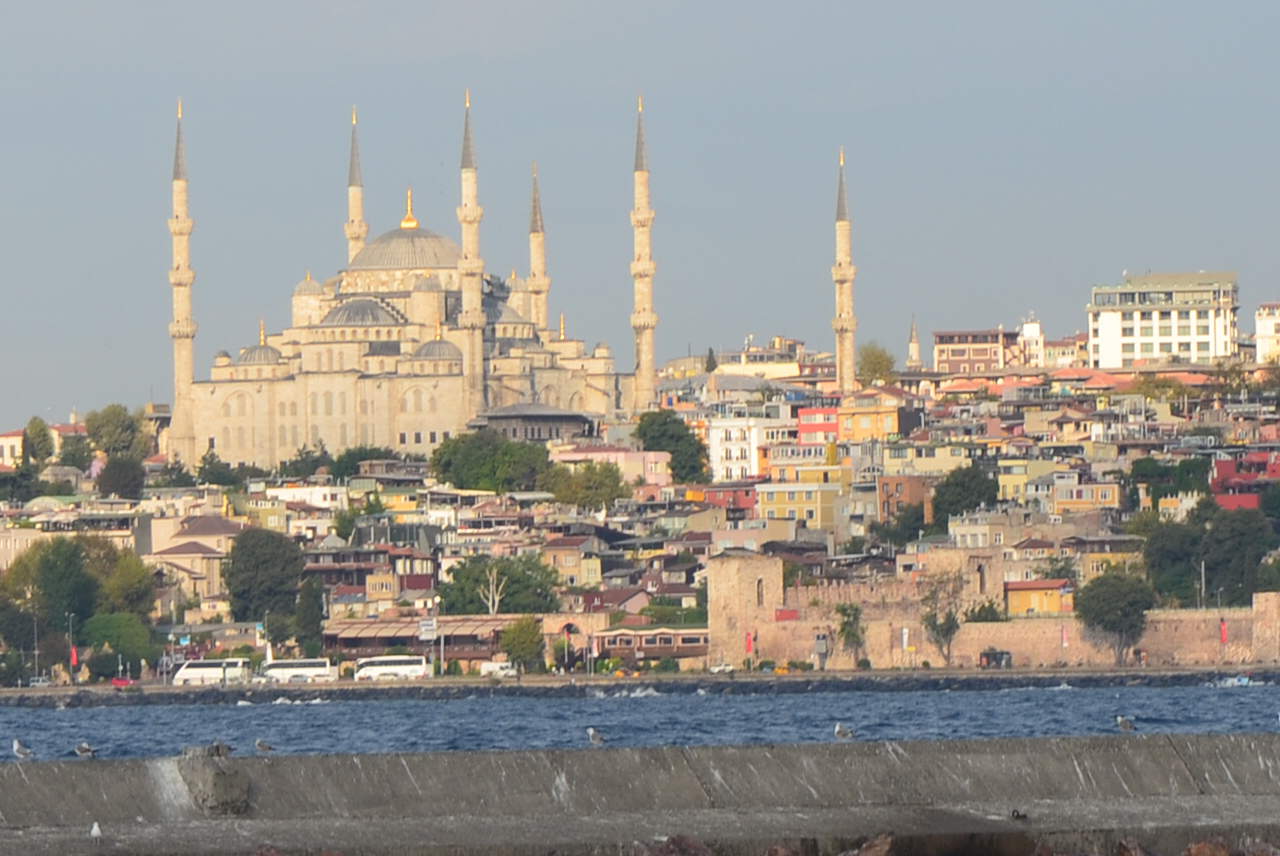Last updated on .
The Blue Mosque (Sultan Ahmet Camii) is one of the most magnificent buildings in Turkey and a popular tourist attraction in Istanbul. It’s located in Sultanahmet, the heart of the UNESCO World Heritage listed old city, directly across from its rival, Hagia Sophia.

History of the Blue Mosque
The mosque was built on top of a section of the old Byzantine emperor’s palace between 1609 and 1616 during the reign of Sultan Ahmed I. Constructed during a period of decline and uncertainty, the mosque was meant to reassure Ottoman citizens of the power of the empire. It was funded by the Ottoman treasury and not by the spoils of war as previous imperial mosques had been, making the decision to build it an unpopular one.
The architect was Sedefkâr Mehmed Ağa (1540-1617), a student of the great Mimar Sinan (1490-1588), and his goal was to surpass the grandeur of Hagia Sophia. He designed the mosque with five main domes and eight smaller ones. It was the first mosque built with six minarets, which angered many people because the Masjid al-Haram in Mecca only had four at the time (Murad IV added three minarets in Mecca in 1629). Click here for a few virtual tours of the mosque.
Visiting the Blue Mosque
The Blue Mosque is open daily, but visitors can only enter outside of prayer times. Women must cover their heads. All visitors must dress modestly (women should cover their shoulders and legs, no shorts for men) and remove their shoes. Scarves are provided for women at the entrance as well as plastic bags for carrying shoes. There is no admission to enter.
You can take your time visiting the interior, although 15 minutes is usually more than enough. Please notice the wooden barrier separating the tourists from the rest of the prayer hall. Tourists are not permitted to pass the barrier. After you finish, exit through the doors to the north, put your shoes back on, and return any scarves and plastic shoe bags.
Features of the Blue Mosque
The Blue Mosque has several interesting features both on the exterior and interior.
Courtyard
The courtyard of the mosque has three entrances, including a monumental entrance on the northwest side. There are colonnaded porticoes on all 4 sides, with 26 columns supporting 30 domes. An ablutions fountain sits in the center, but today ablutions are performed at taps outside the courtyard. The main entrance to the prayer hall is on the courtyard, but tourists must enter from another entrance on the south side.
Prayer Hall
As soon as you enter the prayer hall, you’ll notice the splendor and stunning artwork from floor to ceiling. It doesn’t look nearly as big as you’d expect from the outside, but it’s still a spectacular sight. It covers an area of 64 x 72 meters (210 x 236 feet).
The Blue Mosque is adorned with over 20,000 handmade ceramic Iznik tiles. The blue tiles, which depict tulips, give the mosque its nickname. There are also over 200 beautiful stained glass windows. The glass was a gift from the Republic of Venice.
The mihrab is carved out of marble and has two inscription panels above. The minbar is also carved out of marble and decorated with gold. The mosque is designed so that as long as you aren’t standing behind a pillar, you can see both the mihrab and minbar.
The sultan’s loge is on the upper level of the southeast corner of the prayer hall. It provided a place for the sultan and his court to pray in private. The L-shaped platform is supported by 10 marble columns and is accessed from the exterior via the Imperial Pavilion. The Imperial Pavilion consists of a covered ramp leading up to two rooms. It served as the headquarters of the Grand Vizier during the Janissary Rebellion of 1826.
Dome
The central dome measures 23.5 meters (77 feet) in diameter and is 43 meters (141 feet) in height. The dome rests on four massive pillars and is surrounded by four semi-domes. Each semi-dome is flanked by three small exedrae, and four more small domes sit at the corners. The central dome has 28 windows, each semi-dome has 14, and each exedra has 5.
Sultan Ahmed Complex
The Blue Mosque was the focal point of the Sultan Ahmed Complex (Sultan Ahmed Külliyesi). In addition to the mosque, there was a madrasa, hospital, guesthouse, soup kitchen, hamam, primary school, bazaar, and the Tomb of Ahmed I. Only the madrasa, primary school, tomb, and bazaar survive today. The hospital, guesthouse, and soup kitchen were demolished to make way for the Marmara University Rectorate while the hamam is partially ruined. The Tomb of Ahmed I is covered in a separate post.
Sultan Ahmed Madrasa
The Sultan Ahmed Madrasa (Sultan Ahmed Medresesi) sits northeast of the mosque. It was completed around 1620. The madrasa consists of a rectangular courtyard surrounded by 24 student cells and a large domed classroom on the northeast corner.
Arasta Bazaar
The Arasta Bazaar is situated right underneath the Blue Mosque to the southeast. It was built completed in 1617 and contains about 200 stalls. Rent from the stalls were used for upkeep of the Blue Mosque. The Ottoman cavalry corps used to purchase their gear there.
The Arasta Bazaar burned down in 1912 and was left in ruins for decades. It was restored between 1982 and 1985 and reopened as a bazaar. There are some excellent shops selling souvenirs, carpets, clothing, jewelry, and more. At the north end of the bazaar is an area with cafés and restaurants.